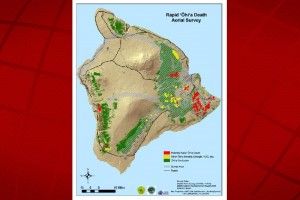DLNR: Ohia Wilt Spread Larger than Originally Thought
Rapid ohia death, or ohia wilt, a fungal infestation that attacks ohia trees, may be spreading more rapidly that initially thought.
Using helicopter and specialized survey equipment, surveyors made up of state, county, and federal agencies flew the surveyed 810,000 acres of land on the Big Island between Jan. 11 and Jan. 15.
In 2014, satellite imagery showed that about 15,000 acres has been infected by the disease; now pending ground verification, the infection is believed to have spread to 34,000 acres of ohia forest on the Big Island.
“We used two surveyors at a time and flew a total of eight-and-a-half hours over state, federal, and private lands, covering about two-thirds of the Big Islands’s ohia forests,” said Philipp LaHaela Walter, the State Resource and Survey Forester for the DLNR Division of Forestry and Wildlife. “Our next steps are to cover the rest of the ohia forests with follow-up flights and to ground-truth the aerial operation.”
A first time detection in the Kohala area was found for the first time, according to Walter, who said that one of the top priorities will be to double-check the Kohala area.
“Unfortunately, rapid ohia death is spreading much quicker than we had hoped. The aerial surveyors noted ohia trees with no leaves or brown leaves, likely impacted by the disease, as well as ohia trees which have been dead for a longer time and those that have been affected by either drought or vog,” said Dr. Flint Hughes with the United States Department of Agriculture Forest Service. “It’s important that we differentiate the causes of tree deaths and continue to carefully and closely monitor the spread of rapid ohia death to aid in reducing its spread on Hawai’i Island and around the state.”
About 865,000 acres of land across the state is covered in ohia forests. The forests are considered the primary species that provide habitat for a number of plants, animals, and invertebrates. In addition, the forests protect watershed that provide agriculture and drinking water across the state.
“It’s sad, but not unexpected that we have a confirmed case of rapid ohia death in Hawai‘i Volcanoes National Park,” said HVNP Superintendent Cindy Orlando. “We are very concerned about the impacts to our cherished ohia that thrives throughout the park, and we will continue to implement the stringent measures developed by our interagency partners to prevent the spread of this devastating disease. We will also continue to sample trees throughout the park.”
Dr. J.B. Friday, the extension forester with the UH College of Tropical Agriculture & Human Resources Cooperative Extension Service, said the USDA moratorium on the transport and shipment of ohia plants and parts is having a positive effect on curbing the spread of the disease.
“It’s impossible to determine whether the ban on ohia shipping is 100 percent effective and that’s why we are trying to get the word out to all forest users, nurseries, and lei makers that rapid ohia death is fast killing what is considered one of the most important forest trees in Hawai’i,” Dr, Friday said.
In 2014, USDA researchers were able to identify the pathogen that causes the disease.
Research into treatments for the particular fungus that causes rapid ohia death continues at the USDA Agricultural Research Service lab in Hilo. An investigation into how it spreads is also being conducted, with potential culprits being insects, underground via roots, on small wood or dust particles, on clothing and shoes, and possibly on animals.
Scientists hope that by identifying what spreads the disease, the impact would be mitigated.
Experts from DLNR DOFAW, the USDA Forest Service, the Big Island Invasive Species Committee, and the National Park Service Hawai’i Volcanoes National Park conducted the aerial survey, while the University of Hawai’i Cooperative Extension Service and USDA Agricultural Research Service assisted in the planning.













